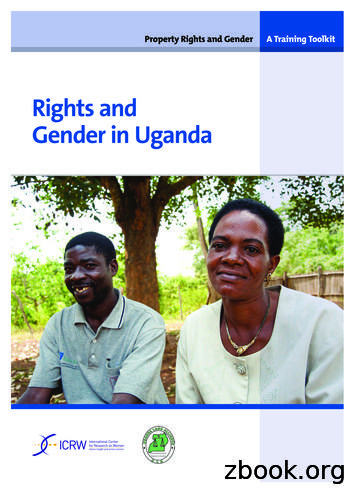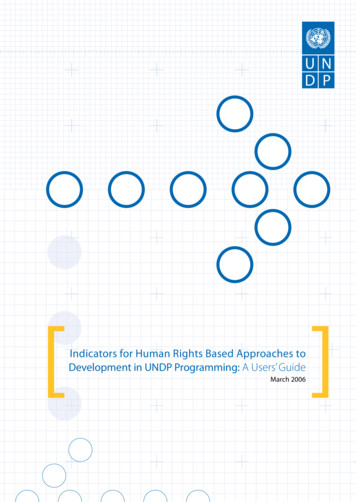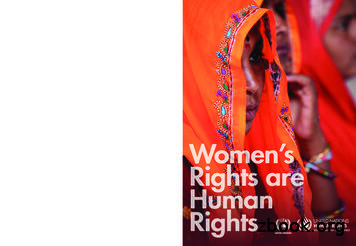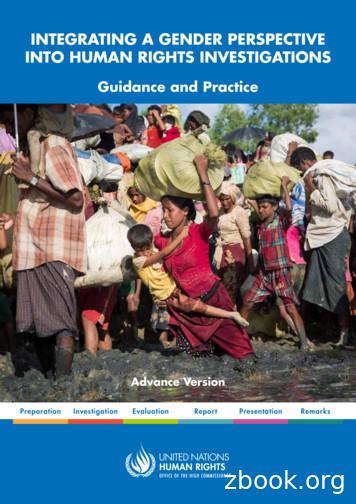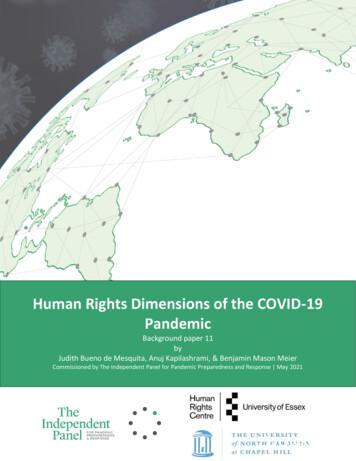Integrating Human Rights Into Environmental, Social And Health Impact .
Integrating human rights intoenvironmental, social and healthimpact assessmentsA practical guide for the oil and gas humanrights.dk
The global oil and gas industry association for environmental and social issues5th Floor, 209–215 Blackfriars Road, London SE1 8NL, United KingdomTelephone: 44 (0)20 7633 2388 Facsimile: 44 (0)20 7633 2389E-mail: info@ipieca.org Internet: www.ipieca.orgThe Danish Institute for Human RightsWilders Plads 8K, 1403 Copenhagen K, DenmarkTelephone: 45 32698888 Facsimile: 45 32698800E-mail: info@humanrights.dk Internet: www.humanrights.dk IPIECA/DIHR 2013 All rights reserved.No part of this publication may be reproduced, stored in a retrieval system, or transmitted inany form or by any means, electronic, mechanical, photocopying, recording or otherwise,without the prior consent of DIHR/IPIECA.This publication has been developed to support the implementation of IPIECA’s mission and vision.Whilst every effort has been made to ensure the accuracy of the information, it is intended toprovide general guidance only. It is not designed to provide legal or other advice, nor should it berelied upon as a substitute for appropriate technical expertise or professional advice. All attemptshave been made to ensure the information is correct at of the date of publication. This publicationdoes not constitute a mandatory commitment which members of IPIECA are obliged to adopt. Theviews and conclusions expressed herein do not necessarily reflect the views of all IPIECA membersor the individuals, companies and institutions that contributed to this publication.While reasonable precautions have been taken to ensure that the information contained in thispublication is accurate and timely, this publication is distributed without warranty of any kind,express or implied. IPIECA does not endorse or accept responsibility for the content or availabilityof any website referred to, or linked to, in this publication. The responsibility for the interpretationand use of this publication lies with the user and in no event will IPIECA nor any of its memberspast, present or future regardless of its or their negligence, assume liability for any foreseeable orunforeseeable use made thereof, which liability is hereby excluded. Consequently, such use is atthe recipient’s own risk on the basis that any use by the recipient constitutes agreement to theterms of this disclaimer. This disclaimer should be construed in accordance with English law.
Integrating human rights intoenvironmental, social and healthimpact assessmentsA practical guide for the oil and gas industryPhotographs reproduced courtesy of the following: front cover and pages ii, 1, 12, 13, 15, 16, 19, 22, 26, 29 and 30: Shutterstock.com;pages 2 and 4: iStockphoto.com.
CONTENTSIPIECA DIHRIntroduction2Part 1: Human rights issues and impactsin the oil and gas industry3What are human rights impacts?3Assessment of potential human rights impacts4Part 2: Human rights considerationsin the ESHIA* process steps10Stakeholder engagement throughout theimpact assessment process11Guide to integrating human rights in theESHIA process steps11Step 1: Project screening12Step 2: Scoping and Terms of Reference13Step 3: Baseline studies15Step 4: Identification and assessment of impacts 16Step 5: Impact mitigation and management17Step 6: Monitoring, evaluation, communicating 19and reportingPart 3: Strategic themes and processesii21Integrated impact assessment ordedicated human rights impact assessment21Strength testing the assessment ofhuman rights impacts21Stakeholder engagement and participation23Considerations and options whencommunicating about human rights impacts25Focus on vulnerable individuals and groups,gender and Indigenous Peoples27Organizational skills and resources forthe assessment and management ofhuman rights impacts29Next steps and further information29* Environmental, social and health impact assessment
INTEGRATING HUMAN RIGHTS INTO ENVIRONMENTAL, SOCIAL AND HEALTH IMPACT ASSESSMENTSAppendix 1: Further examples from practice30ACKNOWLEDGEMENTSAppendix 2: Key international human rightsinstruments and resources32Appendix 3: Summary of the expectationsof the United Nations Guiding Principles onBusiness and Human Rights (UNGPs) and theoil and gas industry36In the development of this Guidance, IPIECA and DIHRsought the input from an external panel of independentexperts to challenge our thinking and provide critiqueat key points in the drafting process. While it was notpossible to incorporate all feedback, their contributionshave been invaluable. The list of the panel membersbelow does not suggest full endorsement of thecontent. Panel members provided their time on avoluntary basis and we thank them for their efforts.Appendix 4: The principles of the SIAcommunity (Vanclay, 2003)37Panel membersAppendix 5: Human rights-basedapproach principles38Appendix 6: ‘Significance’ versus ‘severity’39Resources Professor Frank Vanclay, Faculty of Spatial Sciences,University of Groningen David Snashall, Environmental ResourcesManagement (ERM) Dr Deanna Kemp, Centre for Social Responsibility inMining, Sustainable Minerals Institute, University ofQueensland Julie Kim, Centre for Social Responsibility in Mining,Sustainable Minerals Institute, University ofQueensland Mark Wielga, NewFields Susan Joyce, OnCommonGround401
INTRODUCTIONIPIECA DIHRTargeted at ESHIA practitioners in the oil and gasindustry and in consulting firms, the Guide is structuredinto three parts and uses text boxes and case studies toclarify, illustrate and provide practical examples.his Guide describes how human rights can beintegrated into environmental, social and healthimpact assessments (ESHIAs), which the oil and gasindustry routinely uses to evaluate projects andactivities. It provides an introduction to human rightsand their relevance to the activities of the oil and gasindustry, and briefly describes why it is important for theoil and gas industry to consider the impact that itsprojects and activities have on human rights.TIt is the product of collaboration between impactassessment practitioners from IPIECA members andhuman rights practitioners from the Danish Institute forHuman Rights (DIHR). Together, the organizations haveattempted to bridge the gaps in terminology, processesand approaches between the ESHIA and human rightsimpact assessment communities.The Guide’s objectives are to: foster inclusion/integration of human rights intoESHIAs conducted for projects undertaken by the oiland gas industry; provide human rights insights on the key processsteps in international standard ESHIAs1; and provide a new practical reference point in anevolving field of assessing human rights impacts.2Part 1: Human rights issues and impacts in the oil andgas industry. This section contains high-levelinformation about human rights, defining human rightsimpacts and their scope, and outlines the parallelsbetween ESHIAs and the assessment of human rightsimpacts.Part 2: Human rights considerations in the ESHIAprocess steps. The section follows the steps of theESHIA process, providing practical guidance onapplying a human rights lens to the activities andcontent of each step.Part 3: Strategic themes and processes. This sectionlooks at human rights issues that are applicable acrossthe ESHIA process: i) Integrated impact assessment ordedicated human rights impact assessment; ii) Strengthtesting of the assessment of human rights impacts;iii) Stakeholder engagement and participation;iv) Considerations and options when communicatingabout human rights impacts; v) Focus on vulnerableindividuals and groups, gender and Indigenous Peoples;and vi) Organizational skills and resources for theassessment and management of human rights impacts.The Guide builds on previous IPIECA publications2,3,4and on good practice guidance from the InternationalFinance Corporation (IFC)5,6. Information from theseresources is referenced, but not duplicated as readerscan easily access these sources.1For the purposes of this Guide, international standard ESHIAs are defined as those ESHIAs which follow the social impact assessment principles of the IAIA(Vanclay, 2003) and the IFC Performance Standards (2012).2IPIECA (2012a). Human rights due diligence process: a practical guide to implementation for oil and gas cations/Due Diligence.pdf3IPIECA (2012). Indigenous Peoples and the oil and gas industry: context, issues and emerging good ations/indigenous people.pdf4IPIECA (2013). Human Rights Training Tool—3rd edition: IECA Human Rights training toolkit.zip5IFC (2007). Stakeholder Engagement: A Good Practice 805beacfe6a6515bb18/IFC StakeholderEngagement.pdf?MOD AJPERES6Abrahams, D. and Wyss, Y. (2010). Guide to Human Rights Impact Assessment and Management (HRIAM). International Finance Corporation: www.ifc.org/hriam
PART 1Human rights issuesand impacts in the oiland gas industryil and gas projects can have a range of impacts—both positive and negative—on the human rightsenjoyment of individuals, groups and communities. Forexample, development of oil and gas projects cancontribute to local economies through the generationof revenue for the government or through the creationof jobs. This in turn can have positive impacts onindividuals’ rights to work and on their ability toachieve an adequate standard of living. On the otherhand, resettlement or adverse impacts on livelihoods, ifleft unmanaged, may infringe on the rights toproperty, health and an adequate standard of living forthose affected.OHuman rights are generally defined as basic standards oftreatment to which all people are entitled, regardless ofsex, national or ethnic origin, colour, religion, language,or any other status. The Universal Declaration of HumanRights lists the core human rights to which all humanbeings are entitled, including thirty different rights andfreedoms, covering civil, cultural, economic, political andsocial rights. Appendix 2 on page 32 lists keyinternational human rights resources. The IPIECA HumanRights Training Tool 4 provides learning on thebackground and current state of play of the humanrights and business arena.Consistent with the United Nations Guiding Principleson Business and Human Rights (UNGPs), oil and gascompanies have the responsibility to respect humanrights. Furthermore, companies should exercise duediligence to become aware of, prevent and addressadverse human rights impacts linked to their activities(see Appendix 3 on page 36).IPIECA DIHRWHAT ARE HUMAN RIGHTS IMPACTS?Human rights impacts are influenced largely by the localhuman rights context and the nature of a project’sspecific activities. To be consistent with the UNGPs, thefull range of human rights impacts needs to beconsidered, including those caused or contributed to bythe project, cumulative impacts, and those directlylinked to the project, e.g. through business relationships(see Box 1). An adverse human rights impact occurswhen an action removes or reduces the ability of anindividual to enjoy her or his human rights. The humanrights due diligence process, as articulated by theUNGPs, focuses companies on identifying andaddressing adverse impacts; this is therefore the mainfocus of this Guide. However, the positive contributionsto development by the oil and gas industry should berecognized, and ESHIAs also play a role as a tool toidentify relevant opportunities.Table 1 (pages 5–9) provides a listing of relevant humanrights and possible situations in the oil and gas industry.Further examples are also available in the IPIECA HumanRights Training Tool 4 and IPIECA’s Human rights duediligence process: a practical guide to implementation foroil and gas companies2.BOX 1TYPES OF HUMAN RIGHTS IMPACTSAn actual impact is already present in the project area priorto the project initiation. Legacy impacts are those caused byprevious operators or activities, e.g. insufficient compensationprovided to communities following government-ledresettlement undertaken in relation to project activities.A potential impact is one that may occur at some point, e.g.the project design shows the need for a permanentresettlement of households.A project may cause human rights impacts, e.g. ifdiscrimination occurs in a hiring process.A project may contribute to human rights impacts, e.g. if ituses project contractors with poor labour practices.A project may be directly linked to an impact, e.g. if publicsecurity forces stationed to protect assets use excessive forceagainst protesters.3
IPIECA DIHRASSESSMENT OF POTENTIAL HUMANRIGHTS IMPACTSHuman rights impacts can be identified, assessed andmanaged through a range of company processes andassessments. ESHIAs are already well established in theoil and gas industry. Therefore, integrating humanrights into ESHIAs presents an opportunity for sectorcompanies to assess and address human rights impactsby building on existing systems. For example, some ofthe parallels and overlaps between ESHIAs and theassessment of human rights include the following:1. Issue areas typically considered in ESHIAs are similarto those that are key to human rights, for exampleresettlement, community health and livelihoods.2. Core human rights principles—participation,accountability and transparency, non-discrimination,empowerment and linkage to the internationalhuman rights framework—align in spirit with thesocial impact assessment (SIA) principles of the SIAcommunity7 (see Appendix 5).3. There are significant parallels between the ESHIAand human rights-based approaches, in terms ofprocesses relating to data collection and targetstakeholder groups. For this reason, integratinghuman rights into ESHIAs can be an efficient way ofavoiding or reducing stakeholder engagementfatigue.74Vanclay (2003). Social Impact Assessment—International blications/SP2.pdfWhile there are significant parallels between ESHIAs andthe assessment of human rights impacts, there are alsosome areas of human rights impacts which are not, inpractice, always included in the scope of ESHIAs, orwhich, if included in scope, may warrant furtherattention in practice. Examples include: labour issues with contractors, and within the goodsand services supply chain for the project; post-conflict or conflict-sensitive areas; security activities related to operations; gender analysis, Indigenous Peoples and focus onvulnerable individuals and groups (see pages 27–29for further details); community impacts related to business relationshipsor activities (e.g. partners, government actors or jointventures operations); legacy human rights impacts associated with theactivities of previous operators; cumulative impacts, involving human rights impactsof other companies operating in the same area; and project and in-migration impacts such asoverloading infrastructure and social services.When considering how to integrate human rightsconsiderations into ESHIAs, companies need to payparticular attention to these subject areas and makeconscious decisions about whether such issues are bestcovered as part of the ESHIA process, through othercompany due diligence processes, or in a dedicatedhuman rights impact assessment (HRIA).
INTEGRATING HUMAN RIGHTS INTO ENVIRONMENTAL, SOCIAL AND HEALTH IMPACT ASSESSMENTSTABLE 1 EXAMPLES OF RELEVANT HUMAN RIGHTS AND RELATED SITUATIONS IN THE OIL AND GAS INDUSTRYTopic areasExamples of relevanthuman rightsLand andproperty WorkersRight to ownpropertyRight to adequatehousingRight to a standardof living adequate forthe health and wellbeing of theindividual andhis/her familyRight to participatefreely in the culturallife of communityTreatment of workersshould be consistentwith the InternationalLabour Organization(ILO) Core LabourConventions, i.e.: allow freedom ofassociation andcollective bargaining; prohibit the hiring ofunderage workers, asdefined in relevantILO Conventions; prohibit recruitment,use and practices offorced labour; prohibitdiscrimination inhiring practices orpay; and provide just andfavourable workingconditions.Relevance to the oiland gas industryViewing ESHIA through a human rights lensThe project may acquireland, permanently ortemporarily for use duringconstruction or operations. Communities or individualsmay live on the land anduse it for housing. Theymay use the land foragriculture, watercollection, foraging orother livelihood-securingpurposes. The land mayalso be of cultural, religiousor spiritual value tocommunities orindividuals. Phases of the projectlifecycle will have differentworkforce profiles andintensities. Certain workmay be subcontracted,sometimes multiple times,to various subcontractorswho may hire migrant ortemporary workers.ESHIAs typically consider impacts related to thepresence of contracted workers, e.g. impacts oncommunity health and well-being; they are less likelyto consider the impacts on the welfare of the workersand their dependents. Where potential workerimpacts on human rights are not covered by othercompany processes, consider including them withinthe ESHIA or human rights impact assessmentprocess. Relevant considerations from a human rightsperspective may include: safe and healthy work place conditions; provision of food and water for drinking andsanitation; working conditions and accommodation standards; provision of appropriate personal protectiveequipment (PPE) (by the employer or contractor); whether contract terms and conditions aretransparent and understood by workers prior torecruitment; whether workers have been required to payexcessive recruitment or transportation fees, or tolodge their identity documents or working papers; freedom of movement in and out of the workplaceand workforce accommodation; wages reflective of industry standards/minimumwage; access to workforce grievance mechanisms; and provision of sufficient rest periods and rest days toavoid fatigue.Types of activities whereworker’s human rights maybe at greater risk includeconstruction services,maintenance, security, andfacilities-related servicessuch as cleaning, laundryand catering. Seek to conduct meaningful consultation andengagement with communities who may dependon the land.Consider implications for vulnerable individuals orgroups including indigenous or nomadic peoples.Also consider secondary impacts on specific groupswithin the community; for example, where womenare primary land workers, removal of their access towork the land could also undermine their role in thecommunity.Seek to understand the historical record andcontext relating to land acquisition in the area, andcheck for legacy issues relating to involuntaryresettlement or forced displacement.Consider whether people using the land have title,and if not whether / how they may be compensated.Seek restoration of housing and livelihoods wherephysical or economic resettlement cannot beavoided.continued 5
IPIECA DIHRTABLE 1 EXAMPLES OF RELEVANT HUMAN RIGHTS AND RELATED SITUATIONS IN THE OIL AND GAS INDUSTRY (continued)Topic areasExamples of relevanthuman rightsLivelihood Communityhealth andaccess topublicservices Relevance to the oil andgas industryViewing ESHIA through a human rights lensRight to a standardof living adequate forthe health and wellbeing of theindividual andhis/her familyRight to foodRight to work and tojust and favourableconditions of work(see above)Right to educationRight to freedom ofexpression andaccess to informationRight to the highestattainable standardof physical andmental healthProjects and operationsmay impact both positivelyand negatively upon thelivelihood-sustainingactivities of localcommunities andindividuals. Right to the highestattainable standardof physical andmental healthRight to educationRight to participatefreely in the culturallife of thecommunityRight to equal accessto public service inown countryProjects and operationsmay have an impact oncommunity health andaccess to public services ina variety of ways.People may be dependentupon natural resources forcommercial or subsistenceincome. For example, theproject may require marineexclusion zones, whichcould impact upon localfishing activities, or landacquisition for buffer zonescould impact upon localagricultural activities. Consider whether theproject may: open access topreviously remoteinhabited areas; increase migrant/foreignworkers, leading to anincrease in infectiousdiseases or STDs; put pressure on localhealth resources andinfrastructure, reducingaccess to these services; physically inhibitpeoples’ access to, or useof, public services suchas education; and lead to distortion of localfood prices and basicnecessities. Seek to conduct meaningful consultation andengagement with communities whose livelihoodsmay be impacted by the project, and seek toconsider the significance of the impact from theirperspective.Consider implications for vulnerable communities,including indigenous or nomadic peoples, singleheaded households, individuals below the povertyline, and those who may rely upon subsistence fortheir livelihoods.Consider the potential impact of a change in localemployment patterns or a shift in demand for localskills or competencies resulting from the project oroperation. For example, what is the impact uponchildren’s right to basic education if schoolteachersare recruited to work in more lucrative roles withinthe project.Consider whether information on community orpublic health received from the government isaccurate, for example statistics on certain types ofdiseases and rates of infection or demographicsaffected.Consider whether detailed baseline information oncommunity or public health is available from publicsources, or whether information will have to becreated.Consider in a disaggregated manner, the potentialimpact on different communities or individuals,including vulnerable groups or individuals. Theirresilience to impacts may differ.Where possible, engage directly with potentiallyimpacted communities and individuals. In certaincontexts, it may be helpful to disaggregatestakeholders based on gender, age, ethnicity,sexuality, religion, and susceptibility to specificdiseases or disabilities.continued 6
INTEGRATING HUMAN RIGHTS INTO ENVIRONMENTAL, SOCIAL AND HEALTH IMPACT ASSESSMENTSTABLE 1 EXAMPLES OF RELEVANT HUMAN RIGHTS AND RELATED SITUATIONS IN THE OIL AND GAS INDUSTRY (continued)Topic areasExamples of relevanthuman rightsSecurity Right to life, libertyand security ofpersonRight to freedomfrom torture or cruel,inhuman ordegrading treatmentor punishmentRight to freedomfrom arbitrary arrest,detention or exileRight of detainedpersons to humanetreatmentRight to freedom ofassembly, freedom ofassociation andcollective bargainingRight to a fair trialRight to an effectiveremedyThe industry seeks toprotect people andassets in a manner thatrespects human rightsand is consistent withthe VoluntaryPrinciples on Securityand Human Rights orthe UN Basic Principleson the Use of Forceand Firearms.Water Right to water andsanitationRight to the highestattainable standardof physical andmental healthRight to a standardof living adequate forthe health and wellbeing of theindividual andhis/her familyRight to workRelevance to the oil andgas industryViewing ESHIA through a human rights lensIn certain contexts, theprovision of security to theproject or operation mayinclude the deployment ofarmed personnel (statesecurity forces, i.e. police ormilitary or private security)with potential for the useof force.Where potential impacts on the security of humanrights are not covered by other company processes,consider including them within the ESHIA or humanrights impact assessment process. Relevantconsiderations from a human rights perspective mayinclude the following: When conducting baseline studies and engagingwith the local community, seek to understand anylegacy issues with respect to state or private securityforces. Consider whether the project is located within anarea currently, historically or potentially affected byconflict or violence. Assess the potential for protest activity related tounresolved grievances of the local community orcivil society. Determine whether the project/operation has given,or is likely to be requested to give, any equipment,facilities, funding or help-in-kind to the governmentto assist with the provision of security. Consider whether there may be a risk of (or evidenceof past) human rights abuses against localcommunities by security forces, including genderbased violence. Determine whether human rights are included aspart of the training of security forces, and if not,consider making provision for human rights trainingso that security forces are aware of how to addressworkforce or community related grievances andpeaceful protests.Impacts on thecommunity, individual orworker’s human rights maybe more likely where: there is a culture ofarbitrary arrest, impunityor disregard for therights of people; state or private securityforces have not receivedhuman rights training; people do not haveaccess to a functioninglegal or judicial systemwhere they may seekremedy for potentialhuman rights abuse bysecurity forces.Projects or operations mayhave an impact on theavailability or quality ofwater (constant orseasonal) for use by localcommunities andindividuals (for domestic orcommercial activities). Thismay affect employmentand livelihoods.Where water availability isdepleted, people may haveto travel further to collectwater, resulting in knock-onimpacts on attendance atschool, work, runningbusinesses, etc.Seek to understand:the potential area of influence of the operations onwater resources, in terms of both quality andquantity; who the current users of water within this area ofinfluence are, or who may be affected, upstream ordownstream, by the project or operation’s activities; the status of access to fresh water for drinking andsanitation; how the project or operation may have a potentialimpact on the availability and quality of water (bothon a constant and seasonal basis) in the short,medium and longer term; and continued 7
IPIECA DIHRTABLE 1 EXAMPLES OF RELEVANT HUMAN RIGHTS AND RELATED SITUATIONS IN THE OIL AND GAS INDUSTRY (continued)Topic areasExamples of relevanthuman rightsWater(continued)Relevance to the oil andgas industryViewing ESHIA through a human rights lensIf people have to travel toother sources of water, theadditional distance andpotential hazards en routemay put their health oreven their lives at risk. The lack of available watermay also contribute toconflict or social tensionbetween communities, andmay have longer-termimpacts on migrationpatterns.IndigenousPeoples Right to selfdeterminationRight to ownpropertyRight to adequatehousingRight to a standardof living adequate forthe health and wellbeing of theindividual andhis/her familyRight to the highestattainable standardof physical andmental healthRight to participatefreely in the culturallife of thecommunityRight to equalrecognition andprotection underthe lawRight to nondiscriminationRight to an effectiveremedySpecific collective andgroup rights ofIndigenous Peoples ascaptured in the UNDeclaration on theRights of IndigenousPeoples, 2007 and ILOConvention No. 169.8The project may acquire,either permanently ortemporarily, land forproject construction oroperations. IndigenousPeoples or indigenousgroups may be using thatland for cultural purposes,subsistence, livelihoods orfor shelter/housing.Where appropriate, engage with and consultcommunities and groups regarding water availabilityand quality, seek to understand their current water useand access to fresh water, and help them tounderstand the potential impact of the project oroperation. Consider the potential impact on vulnerablegroups within the community, who may be at greaterrisk if water availability or quality is depleted.Indigenous populations may be particularly vulnerableto potential human rights impacts caused by theproject or operation. Projects may have apotential impact on naturalresources, or on access tothese resources uponwhich Indigenous Peoplesrely for food, water, healthand other aspects of theirlivelihoods.whether there are potentially cumulative impactsfrom other businesses or enterprises in the area orregion, e.g. will the proposed development attractother users of water in the future? Consult with Indigenous Peoples and seek to obtainbroad community support for the project.Design consultation/engagement methods to beaccessible and effective, taking into account peoples’native languages, literacy rates, and the remotenessof any settlements.Seek to understand Indigenous Peoples’ way of life,cultural and religious traditions and the potentialimpact that the project may have on these aspects.Respect traditional indigenous approaches todecision making and consultation.Check that anyone who claims to represent theindigenous population is a true representative andhas the group’s endorsement and support.Although Indigenous Peoples may not have formaltitle to the land that they use, the responsibility torespect their human rights remains. Consider workaround solutions or engagement with thegovernment to find solutions.Governments may not have conferred officialindigenous status upon, or recognized, all potentialindigenous groups. It may be prudent to be sensitiveto this and consider the creation of safe spaces* fordiscussion when developing consultation orengagement plans.* A ‘safe space’ is considered to be a positive, affirming,psychological and emotional environment that encourageshonest and open expression in an atmosphere that is freefrom fear of judgement.continued
INTEGRATING HUMAN RIGHTS INTO ENVIRONMENTAL, SOCIAL AND HEALTH IMPA
applying a human rights lens to the activities and content of each step. Part 3: Strategic themes and processes.This section looks at human rights issues that are applicable across the ESHIA process: i) Integrated impact assessment or dedicated human rights impact assessment; ii) Strength testing of the assessment of human rights impacts;
Rights and gendeR in Uganda · 3 Rights & Human Rights Background Rights The law is based on the notion of rights. Community rights workers need to understand what rights are, where rights come from, and their own role in protecting and promoting rights. Community rights worker
A Human Rights Perspective by David Shiman Raising Children with Roots, Rights and Responsibilities: Celebrating the UN Convention on the Rights of the Child by Lori DuPont, Joanne Foley, and Annette Gagliardi Lesbian, Gay, Bisexual, and Transgender Rights: A Human Rights Perspective by David M. Donahue The Human Rights Education Handbook:
stream human rights into development projects and to monitor and implement a human rights-based approach (HRBA) to development more generally. From the side of human rights, the demand has come from recognition among the human rights treaty monitoring bodies, the Office of the High Commissioner for Human Rights, and a variety of Special .
make up the International Bill of Human Rights. The provisions of the two Covenants, as well as other human rights treaties, are legally binding on . of their human rights, for example marriage and the family. 6 WOMEN’S RiGHTS ARE HUMAN RiGHTS The Convention defines d
Gender analysis is an integral part of a human rights-based approach1, allowing one to see the many ways that gender affects human rights. As a starting point for gender integration, it can propose measures that will close the gender gap between international human rights standards and the everyday human rights situation on the ground.File Size: 679KB
human rights impact of COVID-19 and COVID-19 responses on human rights; the role of global health and human rights governance actors, including the WHO, World Health Assembly, Office of the High Commissioner for Human Rights and UN human rights oversight bodies, suggesting areas of action for
the concept of human rights, this essay will examine the tensions between human rights and state sovereignty, the challenges to the universality of human rights, the enumeration of rights recognized by the international community, and the means available to translate the high aspirations of human rights into practice. II.
MONDAY 11TH JANUARY, 2021 AT 6.00 PM VENUE VIRTUAL MEETING Dear Councillors, Please find enclosed additional papers relating to the following items for the above mentioned meeting which were not available at the time of collation of the agenda. Item No Title of Report Pages 1. FAMILY SERVICES QUARTERLY UPDATE 3 - 12 Naomi Kwasa 020 8359 6146 naomi.kwasa@Barnet.gov.uk Please note that this will .

